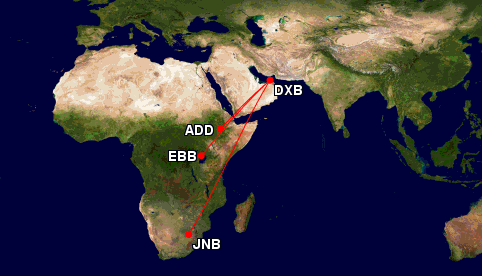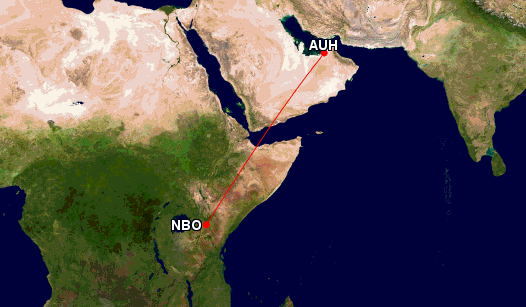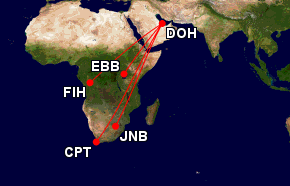The African aviation industry is poorly developed. The enormous economic potential, largely symbolized by the fact that roughly 17% of the world’s population lives in the continent, is overshadowed by regulatory and other political hurdles.
This proves challenging for local African carriers, particularly smaller more vulnerable carriers, especially faced with larger and more established foreign companies. This includes European airlines, but also Middle Eastern carriers who are taking advantage of their geographic position and are leveraging transit potential through their well-established hubs.

The disadvantage of African airlines vis-à-vis Middle Eastern airlines will only be accentuated as they continue to grow. Many of them, both low-cost and premium, have recently announced additional expansion. We take a look at their plans and the impact they will have on other airlines in the region.
Emirates Africa Expansion
Dubai-based Emirates (EK), one of the largest airlines in the world, has revealed that it will be boosting capacity on services to Uganda and Ethiopia.
Emirates is already a significant airline in Africa. According to Cirium data, the carrier ranked seventh in the list of largest airlines in Africa by scheduled seats for the 12 months ending May 2023.
Related
Emirates Resumes Nigeria Flights, Deploys Refurbished 777-300ER to Riyadh
Its position, also as the second largest foreign airline on the continent after Air France-KLM, will be reinforced next summer with additional frequencies and routes. The changes include:
- Dubai, UAE (DXB) to Entebbe, Uganda (EBB): frequencies increased as of 27 October, from five to daily flights with a 777-300ER, adding 718 weekly seats on the route each way. Connections are possible to places such as Canada, the US, India, and the UK among others.
- Dubai, UAE (DXB) to Addis Ababa (ADD): the new daily service will launch on 1 January 2025.
- Dubai, UAE (DXB) to Johannesburg (JNB): a fourth daily flight will be added to the route as of 1 March 2025, operating in the morning. South Africa is “one of the airline’s most in-demand destinations” on the continent.

It first operated in Africa with a flight to Cairo, Egypt, in 1986. Once the above changes are in place, the carrier will be offering 161 weekly frequencies between its Dubai hub and the continent.
Etihad African Routes
Expansion at Etihad (EY) is also expected later this month. Speaking at Routes World 2024 in Bahrain, Etihad Airways Chief Revenue and Commercial Officer Arik De said that the airline would be announcing 11 new cities on November 25. A further 20 will be announced in January or February 2025.

The continental distribution of these new routes is not clear. However, De admitted that while there is a “big gap” in terms of African destinations in its network, the upcoming announcements should primarily feature “secondary cities in Europe and Asia”. Several African destinations will likely be added, though.
As for upcoming expansion this year, Etihad will resume flights to Nairobi in December, flying four times a week from its Abu Dhabi hub.

Qatar Airways Partnership
Key aspects of Qatar Airways (QR) presence in Africa include route expansion earlier this year, as well as its recent investment in South Africa’s independent regional carrier, Airlink, based in Johannesburg. In June, the carrier inaugurated service to Kinshasa, Democratic Republic of Congo, and upped Angola services from once to four times weekly.

In January, QR will celebrate two decades of flights to South Africa, with 35 weekly flights scheduled to the country in the upcoming summer season.
During the southern hemisphere’s summer holiday (during the north’s winter), flights to Cape Town will stand at 11 weekly, rising to 12 weekly between the peak period between 17 December and 13 January.
It increased frequencies to EBB earlier this year between 1 August and 30 September, from one daily to 11 weekly flights. It said at the time:
“The increased frequency now ensures better connectivity for passengers traveling from Uganda to the US, Asia, Europe and North Africa. It also supports the growth of trade and tourism between Uganda and Qatar, while offering convenience for point-to-point passengers to save a day of travel due to early arrival in Doha.”
Hendrif du Preeze, Qatar Airways Vice President for Africa

Flynas New Routes
Saudi low-cost airline Flynas (XY) has also recently been in the news for expansion on the continent. Interestingly, Entebbe features once more.
- Riyadh (RUH) to Entebbe (EBB): launching on 8 January, the three weekly flights will be offered. Connections are not necessarily expected as the carrier’s business model is primarily point-to-point traffic.
- Jeddah (JED) to Djibouti (JIB): launching January 8, these will also run thrice weekly.

Too competitive?
As Middle Eastern airlines enter new markets on the continent, how will African airlines compete? Recent expansion from each of the airlines listed above is concentrated in both South and East Africa, with a particular emphasis on Uganda and South Africa.
Ethiopian Airlines (ET) has a stronghold on most of these markets both domestically and internationally, although the latter is being threatened by the entry of so many of these carriers.
This is even more relevant given the transit capabilities that the three Gulf airlines possess, stealing market share from the Addis Ababa-based airline. Symbolically, Emirates decided to enter the ADD-DXB market.
Westwards on the continent, European carriers maintain somewhat of a monopoly on international flights beyond Africa which geographically speaking makes sense. Journeys to North America via Europe are commonplace, with carriers such as Brussels Airlines (BRU), Air France (AF), KLM (KL), and British Airways (BA) all contributing to this market.
Whether African airlines will be able to keep up is another question.
Feature Image by Clément Alloing | Flickr
Stay tuned with us. Further, follow us on social media for the latest updates.
Join us on Telegram Group for the Latest Aviation Updates. Subsequently, follow us on Google News

